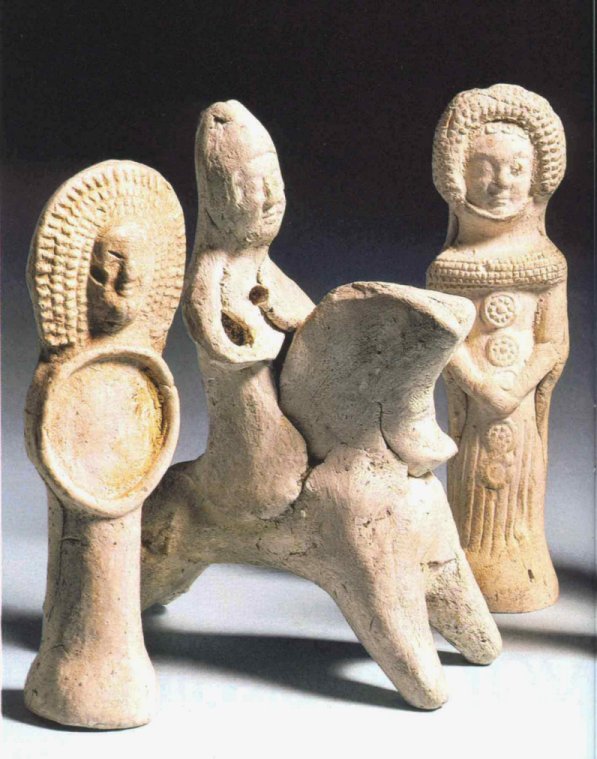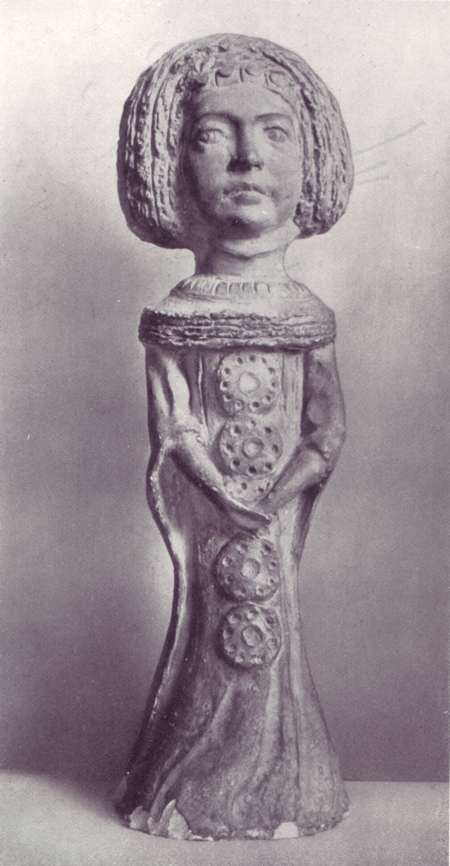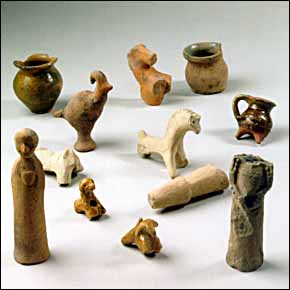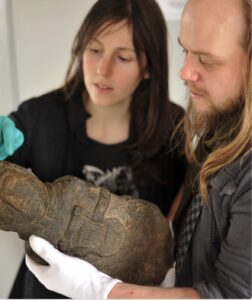What history and archaeology tell us about medieval toys between 1200-1500 AC in Europe? This article present a short synthesis on what we know and how we know about the children game from those periods.
 It is often assumed that children during the medieval era in Western Europe were unloved by their parents. After all only 20-40% survived their first year of life and another 20% to 40% died before puberty and the age of reproduction [1]. Even members of the royal family and the aristocracy who enjoyed a better standard of living for the time were not spared. Indeed, from 1150 to 1500, the procreation of English royalty numbered around 96 children, but only 40 lived past twenty years of age [2]. So why waste valuable resources on children likely to perish so soon?
It is often assumed that children during the medieval era in Western Europe were unloved by their parents. After all only 20-40% survived their first year of life and another 20% to 40% died before puberty and the age of reproduction [1]. Even members of the royal family and the aristocracy who enjoyed a better standard of living for the time were not spared. Indeed, from 1150 to 1500, the procreation of English royalty numbered around 96 children, but only 40 lived past twenty years of age [2]. So why waste valuable resources on children likely to perish so soon?
Nevertheless, archaeological evidence contradicts this perception, as well as a closer examination of manuscripts and texts from the 13th to the 16th centuries. These sources frequently describe toys, which required time and craftsmanship to make and were used for educational purposes to prepare a child for his/her later life. Indeed, starting from the 13th century toys were increasingly manufactured, as there was a profitable market created by loving parents prepared to buy them.
A large majority of toys from this era were made from perishable materials like wood, wax, cloth, or even grass. As such most would have decomposed leaving little evidence for the archaeological record, although some toys did survive. Manuscripts and texts are thus useful to complete what archaeology cannot find anymore, although they mention mainly toys made for the royal classes. The evidence is also more abundant with respect to toys meant for boys. Historians and archaeologists have been able to demonstrate that toys were important during the medieval era, reflecting the relationships between parents and children.
The toys of princes and the high nobility are known from contemporary inventories and were, not surprisingly, of better quality and thus more likely to be well preserved prior to excavation [3]. For those two reasons they are better known. Some display very sophisticated and luxurious craftsmanship, suggesting their destined owners were valued individuals. Most toys for the sons of the rich were related to the art of warfare to prepare them for what was considered to be their main task in adult life. In the 13th century, royal toys included miniature castles, siege engines, and child-sized boats [4]. Sick children could be given toys to pass the time and make them feel better as for Charles VII, future king of France, who fell ill at the age of 2 in 1404 and was given a toy cauldron to play with [5]. Although he was a prince, poorer parents must have behaved similarly with less expensive toys to the extent of their means.

 One of the most frequently represented toys in paintings and manuscripts is the stick-horse [6]. It is widely represented in manuscripts, showing a large range of sophistication, from a simple stick to horses’ heads rendered in detail with manes and reins crafted by adults. A manuscript from the 15th century shows three young boys playing with these sophisticated stick-horses.
One of the most frequently represented toys in paintings and manuscripts is the stick-horse [6]. It is widely represented in manuscripts, showing a large range of sophistication, from a simple stick to horses’ heads rendered in detail with manes and reins crafted by adults. A manuscript from the 15th century shows three young boys playing with these sophisticated stick-horses.
By the 1300s toys for boys were often mass-produced from moulds. They included toy soldiers and other toy animals, the most popular being miniature horses as medieval society was above all equestrian. For example, a lead and tin alloy knight on a horse made from a mould dating to the 14th century was discovered in London [7]. As for votive offerings sold to pilgrims at fairs or pilgrimage sites, such mass-produced toys would have been made and sold by the same merchants or peddlers [8]. In itself this mass-production is indicative of a solvable market necessarily comprised of doting parents or relatives.
 Girls played with toy cooking utensils [10] as well as with dolls. Indeed, the most commonly found items are toy household utensils. Originally painted, these artifacts include a whole array of miniatures of bowls, jugs, ewers, plates, and cutlery such as those uncovered at the site of the Strasbourg castle with miniature pots and jugs [9]. Froissart tells of the pleasure he had in making mud bread loafs and pastries like a baker with his toy cooking utensils. Rich girls also played with toy kitchen utensils, such as the French princess in the late 1300s who received bowls and plates made out of silver [11].
Girls played with toy cooking utensils [10] as well as with dolls. Indeed, the most commonly found items are toy household utensils. Originally painted, these artifacts include a whole array of miniatures of bowls, jugs, ewers, plates, and cutlery such as those uncovered at the site of the Strasbourg castle with miniature pots and jugs [9]. Froissart tells of the pleasure he had in making mud bread loafs and pastries like a baker with his toy cooking utensils. Rich girls also played with toy kitchen utensils, such as the French princess in the late 1300s who received bowls and plates made out of silver [11].
As in most societies the girls played with dolls, preparing for their future lives as adults and mothers. Most dolls were made from textiles, earthenware, wax, grass or wood and thus are rarely preserved. As in the case of toys for boys, they would have often been derived from and resembled the religious votives of saints. In 1943, at the Exeter Cathedral a cache containing votive type objects was uncovered including a wax model of a woman praying [12]. The same model could have been sold as a toy [13]. Dolls could be in the shape of babies or adult figures, but most would probably have mimicked adults since caring for real babies in the form of younger brothers and sisters would have rendered the make-believe of pretend babies somewhat superfluous. The doll’s clothes would have reflected the social status of its owner. Poor girls’ dolls would have had simple clothes while those for the daughters of the nobility would be much more elaborate and adhere to the fashion of the day. In the 14th century Charles ordered for his daughter a doll with a horse and servant [14]. A 1502, a painting shows the daughter of the king of Burgundy holding a doll dressed with the collar, headdress and long dress fashionable at the time [15]. Clearly parents were willing to buy toys for their daughters as well as for their sons. In 1396, in France, a fight between two women for a linen doll caused one to have a miscarriage [16]. The adult dolls would have allowed the girls to mimick in play their future roles depending on their social status [17].
 Together the archaeological record, often in the form of references in texts or pictures due to the use of perishable materials, suggests that toys were important in all classes of medieval society. Many such toys including miniature household utensils, dolls and stick horses are still perennial members of toy repertoires to this day. From the 14th century onwards a market of financially able, caring parents and relatives supported mass manufacture using available technologies. Markets and pilgrimage sites were the best locations to sell these toys, since they were fashioned from the same moulds and materials as religious votives and trinkets. As in all societies the toys allowed the child to imagine and replicate adult life, the better to insert and play his or her future role in society.
Together the archaeological record, often in the form of references in texts or pictures due to the use of perishable materials, suggests that toys were important in all classes of medieval society. Many such toys including miniature household utensils, dolls and stick horses are still perennial members of toy repertoires to this day. From the 14th century onwards a market of financially able, caring parents and relatives supported mass manufacture using available technologies. Markets and pilgrimage sites were the best locations to sell these toys, since they were fashioned from the same moulds and materials as religious votives and trinkets. As in all societies the toys allowed the child to imagine and replicate adult life, the better to insert and play his or her future role in society.
Bibliography:
![]() Alexandre-Bidon D., 1997: « La vie en miniature : dinettes et poupées à la fin Du Moyen Âge », Ludica 3.
Alexandre-Bidon D., 1997: « La vie en miniature : dinettes et poupées à la fin Du Moyen Âge », Ludica 3.
![]() Alexandre-Bidon D. et Closson M., 1985: L’enfant à l’ombre des cathédrales, Presses Universitaires de Lyon, Lyon.
Alexandre-Bidon D. et Closson M., 1985: L’enfant à l’ombre des cathédrales, Presses Universitaires de Lyon, Lyon.
![]() Alexandre-Bidon D. et Lett D., 1997: » Les enfants au Moyen Âge Ve-XVe siècles », Coll. La vie quotidienne, Hachette Litteratures, Paris.
Alexandre-Bidon D. et Lett D., 1997: » Les enfants au Moyen Âge Ve-XVe siècles », Coll. La vie quotidienne, Hachette Litteratures, Paris.
![]() Colvin H. M. et al., 1963: Brown R. A. and Taylor A. J., The History of the King’s works. Vol. 1, The Middle ages, London.
Colvin H. M. et al., 1963: Brown R. A. and Taylor A. J., The History of the King’s works. Vol. 1, The Middle ages, London.
![]() Froissart, n.d.: L’Espinette Amoureuse.
Froissart, n.d.: L’Espinette Amoureuse.
![]() Gauvard Cl., 1991 : « De grace especial : Crime, état et Sociéte en France à la fin du Moyen Âge », vol. 1, Paris.
Gauvard Cl., 1991 : « De grace especial : Crime, état et Sociéte en France à la fin du Moyen Âge », vol. 1, Paris.
![]() Gay V. et Stein H., 1887: Glossaire archéologique du Moyen Âge et de La Renaissance, 2 vol., Librairie de la Société Bibliographique, Nendeln.
Gay V. et Stein H., 1887: Glossaire archéologique du Moyen Âge et de La Renaissance, 2 vol., Librairie de la Société Bibliographique, Nendeln.
![]() Orme N., 2001: Medieval Children, Yale University Press, New Haven and London.
Orme N., 2001: Medieval Children, Yale University Press, New Haven and London.
![]() Radford U. M., 1949: “The Wax Images Found in Exeter Cathedral”, The Antiquaries Journal 29, p. 162-168.
Radford U. M., 1949: “The Wax Images Found in Exeter Cathedral”, The Antiquaries Journal 29, p. 162-168.
[1] Alexandre-Bidon D. et Lett D., 1997, pp. 61-62.
[2] Orme N., 2001, p. 113.
[3] Alexandre-Bidon D. et Closson M., 1985, p. 174.
[4] Colvin H.M. et al., 1963, p. 202.
[5] Alexandre-Bidon D. et Closson M., 1985, p. 180.
[6] Orme N., 2001, p. 175.
[7] Ibid., p. 173.
[8] Ibid., p.172-174.
[9] Alexandre-Bidon D. et Closson M., 1985, p. 180.
[10] Froissart, n.d, verses 180 and on.
[11] Alexandre-Bidon D., 1997, p.148.
[12] Radford U. M., 1949, p. 164-168.
[13] Orme N., 2001, p.169.
[14] Gay B. et Stein H., 1887, p. 273.
[15] Orme N., 2001, p.171.
[16] Gauvard Cl., 1991, p.309.
[17] Alexandre-Bidon D. et Closson M., 1985, p. 180.






